Documentation
Documentation is considered to be an integral part of conservation. It includes identification and description of each object, its association, provenance, condition, treatment along with photographic documentation.
Museums/libraries acquire objects and create collections because the objects convey a significant message or messages. These may be variously historical, religious, economic, technological, and so on. When an object is moved from its place of origin and its context, its significance is reduced and becomes more reliant on the documentation linked to it.
Furthermore, when an object arrives at a museum, it begins a “new life”: it will be studied, positioned, exhibited, restored, loaned and transferred, and will be placed alongside many other objects. It will thus be necessary to identify it in a unique way, and to facilitate the management of every aspect of this new life.
The centre has got facilities to prepare condition assessment, digital documentation, and documentation of art collection of museums, libraries and art galleries.
Some Major Assignments of documentation and condition assessment are
- Condition assessment report of Sir. J.C. Bose Museum, Acharya Bhavan, Kolkata
- Accession register and condition assessment report of Maulana Azad Museum, Kolkata
- Documentation and condition assessment report of Paintings and Statues of Rajya Charukala Parshad, Kolkata
DOCUMENTATION FACILITIES
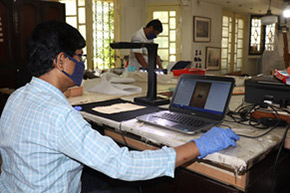
DOCUMENT SCANNER
Document scanning is the process of capture the reflections of scanned documents or text and save these images digitally to picture or PDF formats. With the advancement of scanning technology, most document scanners can distinguish variations in color
Digital documentation
- Burials and grave registers, St. Andrew’s Church, Kolkata
- Rare books and maps Eastern command library, Fort William, Kolkata
PHOTOGRAPHY
Digital SLR Camera use for photographic documentation of the object in before, during and after conservation. This is very useful and helpful documentation process for identify the improvement or anything wrong on the objects during conservation steps.
ULTRAVIOLET LIGHT
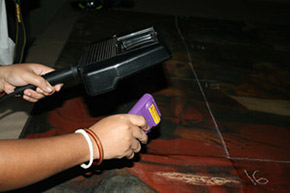
Invisible to the naked eye, UV radiation adjacent to the shorter wavelength region of the visible spectrum is used in examination of works of art, to detect alteration damages, identification of material used, and identification of biological growth. With the help of this radiation one can detect later additions, retouching, and surface coatings.
PH METER
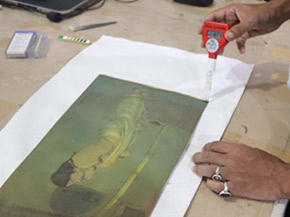
A pH meter is an instrument used to measure acidity or alkalinity of a solution – also known as PH is the unit of measure that describes the degree of acidity or alkalinity. It is measured on a scale of 0 to 14. The pH measured further helps in deciding the material and techniques of conservation. The pH and conductivity meters are used to test paint surfaces and to formulate customized aqueous cleaning solutions. The readings are then used to formulate isotonic aqueous cleaning solutions, which are adjusted to the approximate PH and conductivity of the paint films and paper supports.
LIGHT TABLE
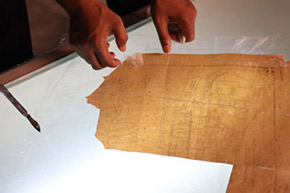
A light table is a viewing device that is used to review photographic film or artwork placed on top of it. A horizontal form of a self-standing light-box, it provides even illumination of the subject from below through a translucent cover and fluorescent lights that emit little heat.
DIGITAL MICROSCOPE (DENO-LIGHT):
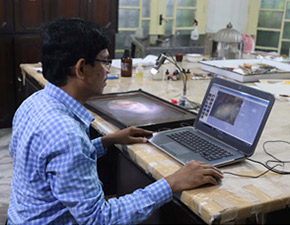
A microscope is to magnify a small object or to magnify the fine details of a larger object in order to examine minute specimens that cannot be seen by the naked eye. It helps the scientists to study the microorganisms, the cells, the crystalline structures, and the molecular structures of the fragment of the object.









